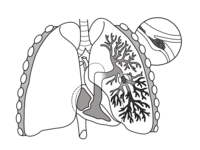
Photo from wikipedia
Anticoagulation control has been associated with risk of thromboembolism and hemorrhage. Herein, we explore the relationship between anticoagulation control achieved in left ventricular assist device (LVAD) patients and evaluate the… Click to show full abstract
Anticoagulation control has been associated with risk of thromboembolism and hemorrhage. Herein, we explore the relationship between anticoagulation control achieved in left ventricular assist device (LVAD) patients and evaluate the association with risk of thromboembolism and hemorrhage. Patients (19 years old or older) with a continuous flow LVAD placed from 2006 to 2012. Percent time spent in target range (PTTR) for international normalized ratio (INR) was estimated with target range of 2.0–3.0. Proportion of time spent in target range was categorized into PTTR > 60%, PTTR ≥ 50 < 60%, and PTTR < 50%. The relationship between PTTR and thromboembolism and hemorrhage was assessed. One hundred fifteen participants contributed 624.5 months of follow-up time. Only 20% of patients achieved anticoagulation control (PTTR > 60% for INR range of 2–3). After adjusting for chronic kidney disease, history of diabetes, history of atrial fibrillation, and age at implant, compared with patients with PTTR < 50%, the relative risk of thromboembolism in patients with PTTR ≥ 60% (hazard ratio [HR]: 0.37; 95% confidence interval [CI]: 0.14–0.96; p = 0.042) was significantly lower, but not for patients with a PTTR of ≥ 50 < 60% (HR: 0.21; 95% CI: 0.02–1.82; p = 0.16). The relative risk for hemorrhage was also significantly lower among patients with a PTTR ≥ 60% (HR: 0.45; 95% CI: 0.21–0.98; p = 0.045), but not among those with PTTR of ≥ 50 < 60% (HR: 0.47; 95% CI: 0.14–1.56; p = 0.22). This current study demonstrates that LVAD patients remain in the INR target range an average of 42.9% of the time. To our knowledge, this is the first report with regard to anticoagulation control as assessed by PTTR and its association with thromboembolism, hemorrhage, or death among patients with ventricular assist devices (VADs).
Journal Title: ASAIO Journal
Year Published: 2017
Link to full text (if available)
Share on Social Media: Sign Up to like & get
recommendations!